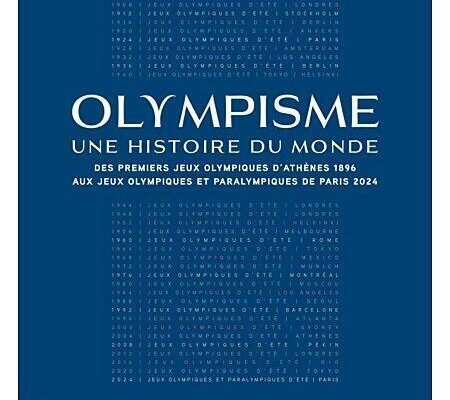From April 26 to September 8, the Palais de la Porte Dorée in Paris hosts the exhibition Olympism, a history of the world (1896-2024). Enough to dive into the heart of the Olympic saga through 33 Olympics. It was from 1920 onwards that the first media stars shook the principle of amateurism. It was also the beginning of the popularity of the Olympics.
5 mins
Telling the history of the world through the history of the Olympic Games is the exhibition’s successful challenge. Olympism, a history of the world 1896-2024on the occasion of the 33rd Olympic Games in Paris next summer.
Strolling through the National Museum of the History of Immigration means first of all discovering works, objects and documents which show to what extent, for 130 years, the Olympic Games have acted as a sounding board for all struggles, dreams and political conflicts in the world. We discover how social, feminist, anti-racist and also anti-colonial movements have influenced the history of the Olympic Games.
1920, the Peace Olympics
From 1920, the general public began to take an interest in the Olympics. In Antwerp, Belgium, the Olympic flame is rekindled for what will be called the “Peace Games”. The Olympic Games are marked above all by great champions.
If initially, it was rich Western men who were able to participate in the Olympic Games, gradually, the working classes, the countries of the South, or even minorities found their place. We remember the swimmer Johnny Weissmuller, an emigrant from Eastern Europe to the United States, who became stateless and had to borrow his brother’s papers to go to Paris in 1924 where he won four medals, including three gold. . Four years later, in Amsterdam, Ahmed Boughéra El Ouafi won the marathon and became the first North African to win a gold medal.
“ It was also from this time that the concert of nations looked at Olympism as something that could be part of the diplomatic game. », explains the historian Pascal Blanchard, one of the curators of the exhibition.
The written press and radio are interested in the Olympics
Being part of the best nations means demonstrating your power. For France in 1924, the idea was to show that the country had rebuilt itself after the Great War. “ In 1932, despite the crisis of 1929, the United States still organized the Olympic Games, saved by the arrival of private sponsors. », recalls Pascal Blanchard. In 1936 in Berlin, three years after Adolf Hitler’s accession to power, Nazi Germany tried to maintain the illusion of a normal country, seeking to erase all traces of anti-Semitism.
It was also from 1920 that the media talked about the Olympics through the written press and the radio. “ This is the beginning of the globalization of sport », notes Pascal Blanchard who does not forget to cite the creation of the Football World Cup in 1930 in Uruguay. The Olympic world quickly understood that media coverage was essential. “ The IOC’s time for amateurism is oversupports Pascal Blanchard. The IOC realizes that the Olympic Games will be the largest universal event organized every four years. »
In 1948, the London Games established the English and American democracies and four years later in Helsinki, the USSR participated in the Olympics for the first time. With 71 medals, the Soviet Union is close behind the United States. Discus thrower Nina Romashkova is the first Soviet gold medalist. “ The interwar period served to create the image of the Olympics ”, according to Pascal Blanchard.
The Olympic Games are marked above all by great champions
From 1920, athletes found their place, often as heroes of the homeland. “ Everyone wanted to take pictures with Johnny Weissmuller, who would later become a Hollywood star », says Pascal Blanchard. In 1952 in Helsinki, Czechoslovakian soldier Emil Zatopek accomplished the unprecedented feat of winning the 5,000 meters, the 10,000 meters and the marathon. Even today, he is recognized as the greatest runner of all time.
The Second World War caused the cancellation of the 1940 and 1944 Olympic Games. Marked by the Cold War, the post-war decades were characterized by an expansion of the Olympic movement towards Oceania, then Asia and Latin America.
Today, the Olympics are marked above all by great champions, like the American Michaël Phelps who ended his career in Rio in 2016 with 28 medals, including 23 gold, over four Olympics. The sponsors snapped up the Jamaican Usain Bolt, who made the heyday of the 100 meters in athletics, the moment of the Olympics which brings together the greatest number of viewers across the planet. During the London Olympics in 2012, 10 million French people were in front of their screens to see the man with eight Olympic gold medals.
Olympism, a history of the world
From the first Olympic Games in Athens 1896 to the Olympic and Paralympic Games in Paris 2024
Edition La Martinière
For those who do not have the opportunity to visit the exhibition, a reference book is available. Around sixty specialists, French and international, offer a complete overview of each of the Olympics and offer a resolutely transnational “world history” of the modern Olympics. This catalog of the exhibition presented at the Palais de la Porte Dorée traces the construction of nation states, the emergence of mass culture, the interwar period marked by the opposition between totalitarianism and democracy, the Cold War, the waves of decolonization or the demands of minorities, the commitment of immigrants and the struggles of emerging countries. It also evokes economic globalization and the gigantism of the contemporary Olympic Games, the recognition of Paralympism, without forgetting to address the ethical and societal questions which run through the Olympic movement today and which question the future of this global gathering.
